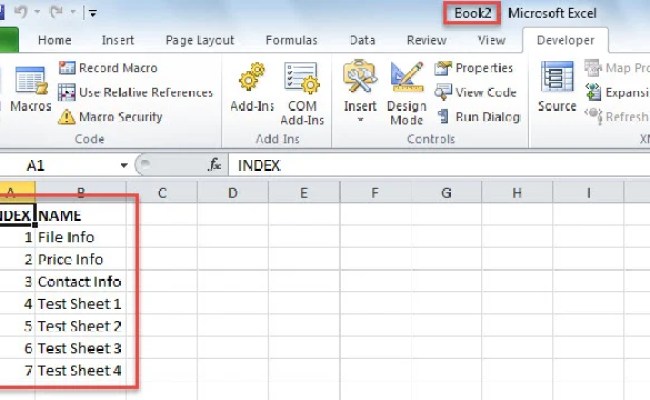Excel Tips: How to Easily Call Sheet Names

Managing multiple sheets in Excel can become quite the challenge as your project grows. However, Excel provides several features and functions that allow you to seamlessly reference sheet names. Whether you're looking to consolidate data, create dynamic summaries, or build interactive dashboards, knowing how to call sheet names efficiently is an essential skill. In this post, we'll delve into various methods and functions you can use to reference and manipulate sheet names in Excel.
Understanding Sheet References

Before we dive into the nitty-gritty of sheet name retrieval, let’s quickly go over how sheets are referred to in Excel:
- Absolute References: This method refers to a specific cell or range on a particular sheet. The format is
=SheetName!CellReference. - Relative References: These change when formulas are copied from one place to another, adjusting automatically to reflect their new position.
🔍 Note: Sheet names containing spaces or special characters must be enclosed in single quotes (e.g., ‘My Sheet’!A1).
Method 1: Using the CELL Function

The CELL function can be used to get information about the formatting, location, or contents of a cell. To retrieve the name of the current sheet:
- Enter this formula into any cell:
=MID(CELL(“filename”,A1),FIND(“]”,CELL(“filename”,A1))+1,255)
- If the sheet name contains spaces or special characters, you need to surround the formula with additional functions:
=MID(CELL(“filename”,A1),FIND(“]”,CELL(“filename”,A1))+2,FIND(“}”,CELL(“filename”,A1))-FIND(“]”,CELL(“filename”,A1))-1)
This formula extracts the name of the sheet in which the formula is entered. It is dynamic, meaning if you change the sheet name, the formula will update automatically.
Method 2: Using Excel’s Name Manager

If you need to reference sheet names in multiple places or build complex models, the Name Manager can be a powerful tool:
- Go to the “Formulas” tab and click “Name Manager.”
- Create a new named range. In the “Refers to” field, you can enter the formula:
=MID(CELL(“filename”,A1),FIND(“]”,CELL(“filename”,A1))+1,255)
- Name it something memorable, like “SheetName.”
Now, wherever you need to refer to the current sheet name, you can simply use =SheetName.
Method 3: VBA for Dynamic References

For more advanced users or when dealing with macros, Visual Basic for Applications (VBA) can provide a custom function to retrieve sheet names:
- Open the Visual Basic Editor with Alt + F11.
- Insert a new module (Insert > Module).
- Enter the following function:
Function GetSheetName() As String GetSheetName = ActiveSheet.Name End Function - You can then use
=GetSheetName()in your Excel cells to display the current sheet name.
Using Sheet Names in Formulas

Once you’ve mastered how to retrieve sheet names, you can start using them in various formulas:
- SUMIF Across Sheets:
=SUMIF('Sheet1:Sheet3'!B:B, ">=0", 'Sheet1:Sheet3'!C:C) - VLOOKUP Across Sheets:
=VLOOKUP(A1, INDIRECT("'"&SheetName&"'!A1:B100"), 2, FALSE) - Create a Summary Sheet: Use sheet names to dynamically pull data from different sheets into a summary sheet.
- Set up a list of sheet names in column A of your summary sheet.
- Use a formula like
=INDIRECT("'"&A1&"'!B2")to retrieve data from cell B2 of the sheet named in A1.
Troubleshooting Common Issues

Here are some common issues and how to address them:
- Formula Not Updating: If the formula doesn’t seem to update when you change sheet names, check if automatic calculation is turned on (Formulas > Calculation Options > Automatic).
- Errors in INDIRECT Function: Ensure the sheet names you reference are correctly typed and exist within the workbook.
- #NAME? Error: This can occur if you’ve tried to use a formula that refers to a named range or function that doesn’t exist. Double-check your references or named ranges.
By implementing these methods and troubleshooting strategies, you'll be well on your way to mastering the art of calling sheet names in Excel. Whether you're creating simple overviews or complex data models, understanding how to dynamically reference sheet names will significantly enhance your efficiency and the interactivity of your workbooks.
💡 Note: Excel's formula and function capabilities are vast, but they also require a good understanding of how Excel manages and processes data. Always make sure your workbooks are organized and your data is well-structured to avoid unexpected results or errors.
Wrapping Up

As we’ve explored various methods to call sheet names in Excel, from simple cell formulas to more complex VBA functions, you now have multiple tools at your disposal. These techniques not only help in managing complex workbooks but also pave the way for creating interactive and dynamic Excel models. Remember to keep your formulas clean, your data well-organized, and your references accurate to ensure smooth functioning of your spreadsheets.
Can I call a sheet name from another workbook?

+
Yes, you can reference sheet names from other workbooks using the full path and name of the workbook, like ='[WorkbookName.xlsx]SheetName'!A1.
How can I list all sheet names in a workbook?

+
You can use VBA to generate a list of all sheet names in the workbook. Here’s a simple code snippet you could use:
Sub ListSheets()
Dim ws As Worksheet
Dim i As Integer
i = 1
For Each ws In ThisWorkbook.Worksheets
Sheets(“Sheet1”).Cells(i, 1).Value = ws.Name
i = i + 1
Next ws
End Sub
What if I have special characters in my sheet names?

+
You must enclose the sheet name in single quotes, like this: ='Sheet Name with Spaces'!A1.



